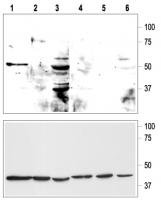Kcnk9 Rabbit Polyclonal Antibody
Other products for "Kcnk9"
Specifications
| Product Data | |
| Applications | WB |
| Recommended Dilution | WB: 1:200-1:2000 |
| Reactivities | Human, Rat |
| Host | Rabbit |
| Clonality | Polyclonal |
| Immunogen | Peptide (C)DDYQQLELVILQSEPHR, corresponding to amino acid residues 57-73 of rat K2P9.1 . Extracellular, near the P1 loop. |
| Formulation | Lyophilized. Concentration before lyophilization ~0.8mg/ml (lot dependent, please refer to CoA along with shipment for actual concentration). Buffer before lyophilization: Phosphate buffered saline (PBS), pH 7.4, 1% BSA, 0.025% NaN3. |
| Purification | Affinity purified on immobilized antigen. |
| Conjugation | Unconjugated |
| Storage | Store at -20°C as received. |
| Stability | Stable for 12 months from date of receipt. |
| Gene Name | potassium two pore domain channel subfamily K member 9 |
| Database Link | |
| Background | K2P9.1 (also named TASK3 or KCNK9) is a member of the 2-pore (2P) domain K+ channels family that probably assemble as dimers to constitute a functional channel. These channels show little time or voltage dependence and are considered to be â??leakâ? or â??backgroundâ? K+ channels, thereby generating background currents which help set the membrane resting potential and cell excitation. The channels are regulated by diverse physical and chemical stimuli including temperature, pH, mechanical stretch, inhalation anesthetics, etc. The physiological role of the K2P channels is not yet clear, though they were proposed to participate in breathing, aldosterone secretion and anesthetic-mediated neuronal activity. In human, expression of K2P9.1 is restricted in brain and its expression overlaps with the structurally related K2P3.1 (TASK1, KCNK3) channel. In rat, it is more widely expressed in other tissues as well as in brain. Unexpectedly, K2P9.1 was found to be over-expressed between 5 to 100-fold in 44% of breast cancer tumors tested. Transfection and over-expression of K2P9.1 in cell lines promotes tumor growth and confers resistance to hypoxia and serum deprivation. Recently, K2P9.1 was found to play an important role in K+-dependent apoptosis of cerebellar granules. |
| Synonyms | K2p9.1; KT3.2; MGC138268; MGC138270; TASK-3; TASK3 |
| Reference Data | |
Documents
| Product Manuals |
| FAQs |
{0} Product Review(s)
0 Product Review(s)
Submit review
Be the first one to submit a review
Product Citations
*Delivery time may vary from web posted schedule. Occasional delays may occur due to unforeseen
complexities in the preparation of your product. International customers may expect an additional 1-2 weeks
in shipping.






























































































































































































































































 Germany
Germany
 Japan
Japan
 United Kingdom
United Kingdom
 China
China




